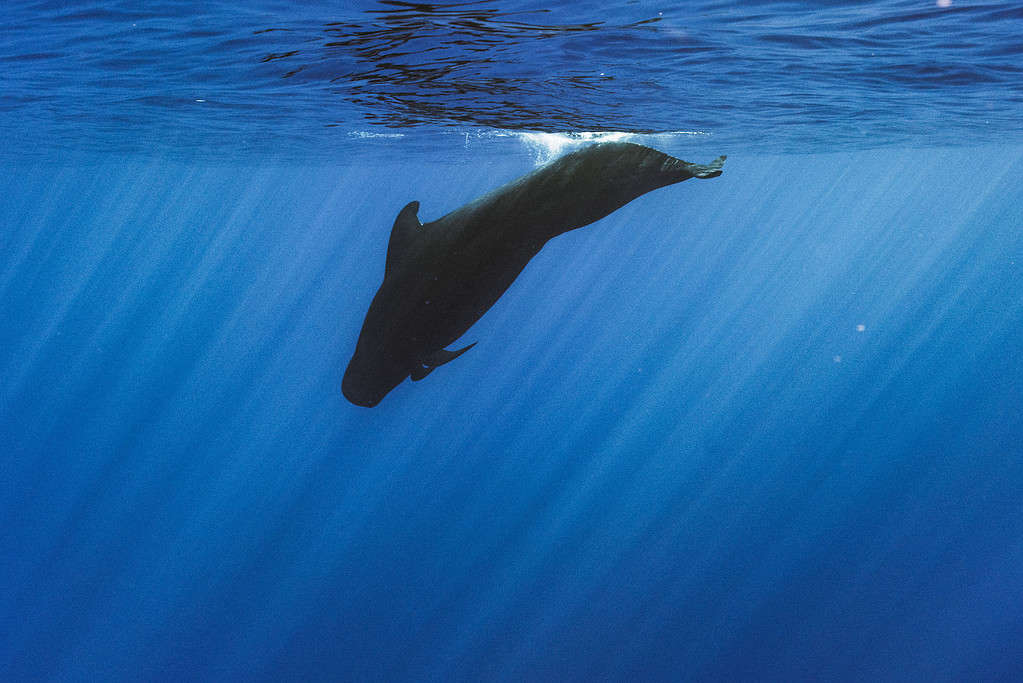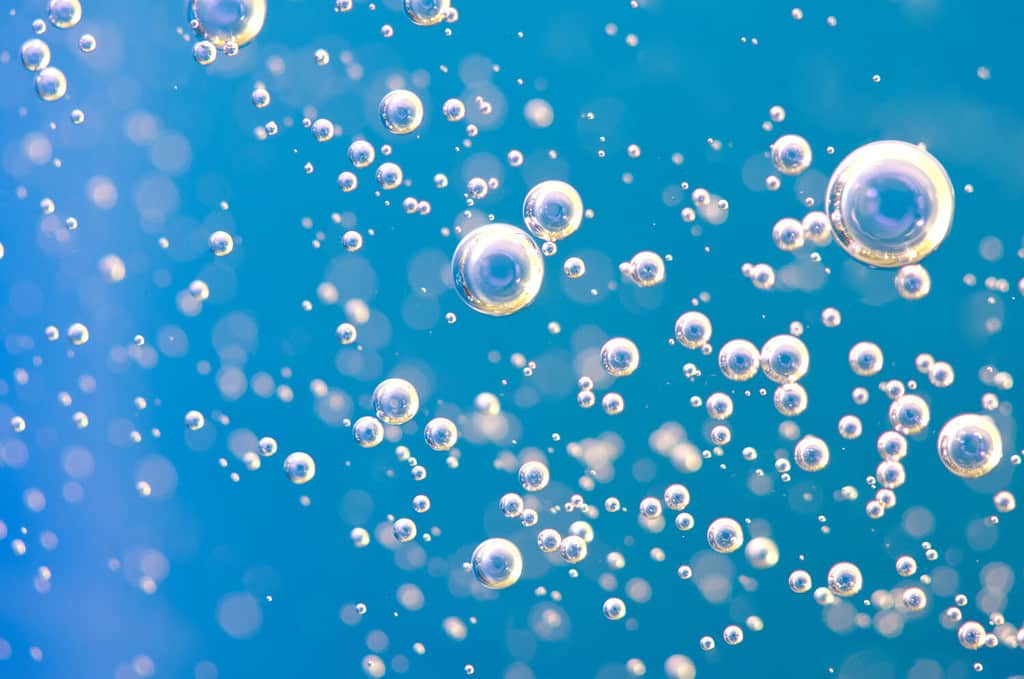Have you heard of the mammalian dive reflex? This physiological response, also known as the diving response, is a natural reaction of the body to submersion in cold water. Today, we’ll take a deep dive and check out what animals this reflex impacts, what it does, and how it works. We’re going to explore all of the impacts of this reflex, including its helpful nature when it comes to combating anxiety and other conditions in humans. Let’s start with what this physiological phenomenon is.
What is the Mammalian Dive Reflex?

A short-finned
pilot whale
(
Globicephala macrorhynchus) diving in blue ocean water. The mammalian dive reflex is most present in mammals like this one – marine life requiring the ability to dive into cold water frequently.
©Wirestock/iStock via Getty Images
The mammalian dive reflex, also known as the mammalian diving response – or just the diving response – is a series of three independent reflexes that occur. These responses actually override basic homeostatic reflexes. Let’s put the three reflexes in a list to look at them more closely.
- Apnea, or breathing cessation. The natural breath-holding reflex kicks in to protect mammals from inhaling water.
- Bradycardia, or a dramatic slowing of the heart rate. This occurs to preserve the warmth and oxygen in the body.
- Increase in peripheral vasoconstriction, or a limiting of blood flow to the limbs and outer organs (like the skin). This also works to protect body temperature and conserve energy.
How Does it Work?
The reflex occurs when the face is submerged and the nostrils are filled with water. There are distinct sensory receptors in the nasal cavity that are sensitive to wetness. These receptors also exist across the rest of the face of most mammals. What effect does this have? It may not sound intuitive, but when the body slows blood flow to the skin, limbs, and organs, it allows the body to protect its heat and conserve oxygen.
So, essentially, the face and nostrils are exposed to water – especially cold water – and the tiny sensory receptors that line the face and inside of the nostrils trigger and send messages to the brain. The brain then slows down the mammal’s heart rate, causes it to hold its breath, and concentrates blood flow to the heart, brain, and lungs.
What Mammals Experience This?

Both humans and dogs experience the mammalian dive reflex.
©iStock.com/Bicho_raro
All mammals, including humans, have the mammalian dive reflex, from the largest land-walkers to the smallest of vertebrates. It is most prominent in marine mammals, such as whales and dolphins, but we can observe the particularly interesting phenomenon of a strong diving response in human babies. We can mostly simplify the experience and say this: most animals that face – or have faced – the threat of asphyxiation are equipped with this reflex.
Why do marine mammals experience this more? This answer makes more sense. These mammals need to dive frequently because of their environments. Constant submersion in cold water necessitates the diving response.
Why Does it Happen?

The mammalian dive reflex helps conserve oxygen – which mammals need in order to survive.
©assistant/Shutterstock.com
So, why does the mammalian dive response happen? The answer to this question is actually quite simple. This response exists entirely to preserve life. Your entire body reflexively starts functioning differently in an attempt to protect you from drowning. The mammal body – yours included – is genetically prewired with a ton of incredible information. Some of this information is hardwired physiological responses to changing environments – especially rapidly-changing ones. You are physiologically-adapted to try to survive. The mammalian dive reflex is just one example of this being true.
When Was This Reflex Discovered?
The first formal study of this reflex wasn’t done until the late 1930s. Yes, this is, overall, relatively new science for us humans. It’s funny to look at an instinctual and uncontrollable physical reactions as “new”. In terms of how we understand something, we have only studied this response for less than one hundred years. The first people to study the mammalian dive reflex were Laurence Irving and Per Scholander. They were the first to describe it as a protective physiological reaction in response to water submersion.
Now, a formal study is different than an informal study or an awareness of a response. We can actually date our vague knowledge back to 1786. Edmund Goodwyn, an English physician, was the first to notedly discover the diving reflex. He did this is a thesis paper for medical school that spoke on advancing artificial ventilation to treat asphyxia. Unfortunately, the physiological adaptations of the reflex would not be recognized until nearly one hundred years later.
Paul Bert, a French physiologist and zoologist, was the next person to note the reflex. While outstanding in his studies of air pressure and oxygen toxicity, he is, perhaps, most famous as a racist. He used pseudoscience to back up his beliefs on European superiority and abused his standing in the scientific community to teach these beliefs in schools. While he did speak on the mammalian dive reflex, there are plenty of people who also did so – before and after him – and we only note his name for due diligence. The most important work in learning about this reflex followed his death by several decades.
How Does it Impact Humans?

Studies suggest that the mammalian dive reflex can help with anxiety.
©Dima Berlin/iStock via Getty Images
Interestingly, the mammalian dive reflex has a variety of impacts on humans. In fact, it is now being used to help treat a variety of ailments. Something as simple as anxiety or a panic attack may be helped by activating this response. More complex issues, such as a condition called paroxysmal supraventricular tachycardia, have been effectively treated by triggering this response. Paroxysmal supraventricular tachycardia, or PSVT, is a type of arrhythmia – an abnormal heart rhythm. According to Hopkins Medicine, this condition occurs when a short circuit rhythm develops in the upper chamber of the heart, resulting in a regular but rapid heartbeat that starts and stops abruptly.
The mammalian dive reflex directly impacts mammalian heart rate. The National Library of Medicine shares a piece by Devon Godek and Andrew M. Freeman that highlights the clinical significance of the mammalian dive reflex in the treatment of PSVT. They state that the primary response of bradycardia (a slowed heart rate) when you trigger the dive reflex is an effective and non-invasive maneuver for the cessation of PSVT. This is not the only example of how this reflex can be helpful to humans. Let’s take a look at it when applied to anxiety and panic disorders.
Anxiety and Panic Disorders
We have already posed that the mammalian dive reflex may help with anxiety and panic attacks, but let’s dig into the science of that. A study by a group of students called “The Implications of the Diving Response in Reducing Panic Symptoms” explores the potential benefits of the reflex when triggered to help with panic disorders. The study included exposing healthy patients and patients with panic disorders to four experimental conditions. One of these conditions was cold facial immersion. Cold facial immersion is the act of submerging your face in cold water – an act that triggers the mammalian dive reflex.
When exposed to cold facial immersion, there were significant reductions in cognitive and physiological symptoms of panic. The group also self-reported less symptoms after this immersion. We’d like to note that this was a study with a small sample size, however, it did have significant outcomes. This study isn’t all that points toward the reflex assisting symptoms of panic disorders. Rachel Swan, MS, has a Masters of Science in Clinical Psychology. In 2022, she published an article for Athena Care that advises triggering the reflex to help you calm down. She isn’t the only one recommending this.
Many different websites tout the efficacy of cold facial immersion and the mammalian dive reflex in treating anxiety. We’ve listed only a few below, which all contain helpful information about quickly treating symptoms of anxiety. We advise that none of this is direct medical advice from our writers or our site and that you should always check with your personal health care professionals when it comes to treatment options or if you have any questions or concerns about your personal experiences or diagnoses.
- The Arlington DC Behavioral Therapy Institute
- New York Behavioral Health
- The Manhattan Center for Cognitive Behavioral Therapy
The photo featured at the top of this post is © DisobeyArt/ via Getty Images
Thank you for reading! Have some feedback for us? Contact the AZ Animals editorial team.







